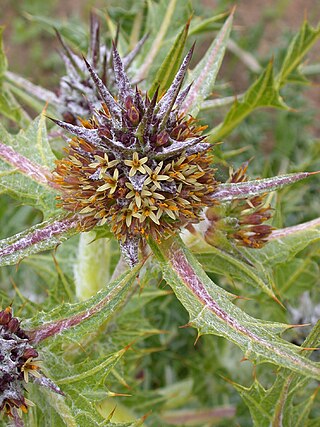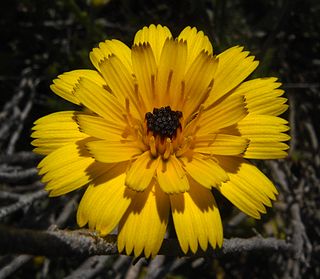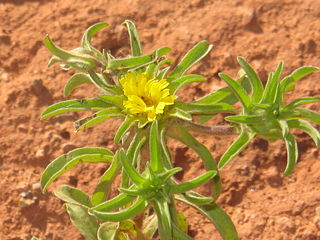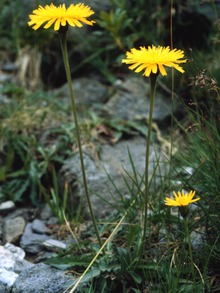
Gundelia or tumble thistle is a low to high (20–100 cm) thistle-like perennial herbaceous plant with latex, spiny compound inflorescences, reminiscent of teasles and eryngos, that contain cream, yellow, greenish, pink, purple or redish-purple disk florets. It is assigned to the family Asteraceae. Flowers can be found from February to May. The stems of this plant dry-out when the seeds are ripe and break free from the underground root, and are then blown away like a tumbleweed, thus spreading the seeds effectively over large areas with little standing vegetation. This plant is native to the eastern Mediterranean and the Middle-East. Opinions differ about the number of species in Gundelia. Sometimes the genus is regarded monotypic, Gundelia tournefortii being a species with a large variability, but other authors distinguish up to nine species, differing in floret color and pubescence. Young stems are cooked and eaten in the Middle-East and are said to taste like a combination of artichoke and asparagus

Scorzonera is a genus of flowering plants in the tribe Cichorieae within the family Asteraceae.

Gnaphalium is a genus of flowering plants in the family Asteraceae, commonly called cudweeds. They are widespread and common in temperate regions, although some are found on tropical mountains or in the subtropical regions of the world.

Crepis, commonly known in some parts of the world as hawksbeard or hawk's-beard, is a genus of annual and perennial flowering plants of the family Asteraceae superficially resembling the dandelion, the most conspicuous difference being that Crepis usually has branching scapes with multiple heads. The genus name Crepis derives from the Greek krepis, meaning "slipper" or "sandal", possibly in reference to the shape of the fruit.

Leontodon pyrenaicus is a species of hawkbit found in the Alps, Pyrenees, Cantabrian Mountains, northern Apennines and northern parts of the Balkan Peninsula. It grows in meadows and on stony slopes from the tree line to over 3000 m, usually on acidic soils. It is perennial, and flowers from June to August.

Microseris is a genus of plants in the tribe Cichorieae within the family Asteraceae, plants that often called composites. They are native to North America, South America, Australia, and New Zealand.

Cicerbita alpina, commonly known as the alpine sow-thistle or alpine blue-sow-thistle is a perennial herbaceous species of plant sometimes placed in the genus Cicerbita of the family Asteraceae, and sometimes placed in the genus Lactuca as Lactuca alpina. It is native to upland and mountainous parts of Europe.

The Cichorieae are a tribe in the plant family Asteraceae that includes 93 genera, more than 1,600 sexually reproductive species and more than 7,000 apomictic species. They are found primarily in temperate regions of the Eastern Hemisphere. Cichorieae all have milky latex and flowerheads that only contain one type of floret. The genera Gundelia and Warionia only have disk florets, while all other genera only have ligulate florets. The genera that contain most species are Taraxacum with about 1,600 apomictic species, Hieracium with about 770 sexually reproducing and 5,200 apomictic species, and Pilosella with 110 sexually reproducing and 700 apomictic species. Well-known members include lettuce, chicory, dandelion, and salsify.

The Cichorioideae are a subfamily of the family Asteraceae of flowering plants. Familiar members of Cichorioideae include lettuce, dandelions, chicory and Gazania species. The subfamily comprises about 240 genera and about 2900 species. It is heterogeneous and hard to characterize except with molecular characters.
Lactuca orientalis is a Eurasian species of plant in the tribe Cichorieae within the family Asteraceae. It is widespread across the Middle East and southern Asia as far east as Tibet.

Helminthotheca echioides, known as bristlyoxtongue, is a sprawling annual or biennial herb native to Europe and North Africa. It was originally placed within the genus Picris but is often separated within the small genus Helminthotheca alongside a few other plants which also have the distinctive outer row of bracts around the flowerheads. It is a ruderal plant, found on waste ground and agricultural soils around the world, and in some places it is considered a troublesome weed.

Elephantopus is a genus of perennial plants in the daisy family (Asteraceae).

Tolpis is a genus of flowering plants in the tribe Cichorieae within the family Asteraceae. It is native to Africa, Southern Europe, the Middle East and Macaronesia. Many species are limited to the Canary Islands.

Rhagadiolus is a genus of plants in the tribe Cichorieae within the family Asteraceae, native to the Mediterranean region of southern Europe, northern Africa, and the Middle East.

Scorzoneroides autumnalis, commonly called autumn hawkbit, is a perennial plant species, widespread in its native range in Eurasia, and introduced in North America.

Reichardia is a genus of plants in the tribe Cichorieae within the family Asteraceae native to the Mediterranean and western Asia. In Crete, Greece the leaves and tender shoots of a variety of Reichardia picroides called galatsida (γαλατσίδα) are eaten raw, boiled, cooked in steam or browned with olive oil by the locals. Brighteyes is a common name for plants in this genus.

Scorzoneroides or hawkbits is a genus of plants of the tribe Cichorieae within the family Asteraceae.
Garhadiolus is a genus of Asian plants in the tribe Cichorieae within the family Asteraceae.
Phitosia is a genus of Greek plants in the tribe Cichorieae within the family Asteraceae.

Asteriscus aquaticus is a species of flowering plant. The flower is part of the so-called "Asteriscus alliance".


















